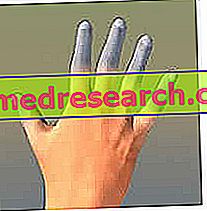What is Acrocyanosis
Acrocyanosis is a microcirculatory disorder characterized by a persistent bluish discoloration of the extremities of the body.

Acrocyanosis occurs symmetrically, especially in the hands, feet and distal parts of the face. Often, the extremities of the body are cold, they sweat profusely and can swell. Unlike Raynaud's phenomenon, acrocyanosis is not easily reversible, pain is absent, no trophic alterations or ulcerations occur and the peripheral arterial pulse is normal.
Pathophysiology
The disorder is due to a constriction of the small skin vessels. The consequent slowing of blood circulation locally, and the desaturation of oxygen in the resulting blood, are manifested clinically with peripheral cyanosis (bluish-violet color of the extremities).
Causes
The exact etiology of the acrocyanosis is unknown. Sometimes the condition has been reported as a side effect of drugs and other substances. Some epidemiological data suggest that cold climate, occupational exposure and low body mass index (BMI) constitute risk factors. Furthermore, acrocyanosis is prevalent in young women (under the age of 30) and often resolves completely after menopause. It is therefore believed that vasospasm is associated with neurohormonal abnormalities.
Primary acrocyanosis
Essential (or primary) acrocyanosis is a benign condition, sometimes associated with a neurohormonal disorder. Generally, it tends to regress spontaneously and does not require specific treatment. An emergency medical intervention, on the other hand, may be necessary if the extremities are exposed to extreme cold for an extended period of time. However, acrocyanosis differs from freezing : the latter condition is often associated with pain (the reflex pathway of thermal nociceptors warns of danger).
A number of other conditions affecting the hands, feet and parts of the face, with associated skin color changes, must be differentiated from the acrocyanosis:
- Raynaud's phenomenon : reversible episodes of cutaneous pallor of the fingers or toes, due to the constriction of small vessels exposed to cold or strong emotional stress;
- Geloni (erythema pernium) : skin irritation, caused by prolonged exposure to intense and wet cold;
- Acrorigosi : permanent and symmetrical cold sensation at the extremities, associated with skin pallor;
- Erythromelalgia : vasodilation caused by an increase in skin temperature, which occurs with local heat, marked redness and very intense pain.
In some cases, the diagnosis can be difficult, especially if these syndromes coexist.
Secondary acrocyanosis
Acrocyanosis can also be associated with a more serious health problem, which must be sought during the diagnostic investigation. The causal conditions include: connective tissue disorders, neurological disorders, vasculitis, problems leading to central cyanosis, antiphospholipid antibody syndrome (APS), cryoglobulinemia, infections, toxicity and neoplasms. In these cases, the observed skin alterations are known as "secondary acrocyanosis". These can have a less symmetrical distribution, express themselves at a more mature age and can cause pain and tissue damage. In general, the correct treatment of the underlying condition can reduce the secondary symptomatology of acrocyanosis.
Signs and symptoms
Acrocyanosis is a condition characterized by persistent, symmetrical, uniform and painless peripheral cyanosis. The extremities are often cold and the skin can be edematous. Hands and feet have palmar-plantar hyperhidrosis.
Unlike the closely related phenomenon of Raynaud, cyanosis is therefore persistent. Furthermore, usually trophic skin alterations, localized pains or ulcerations are absent.
Diagnosis
Acrocyanosis is diagnosed based on medical history and physical examination.
Pulse oximetry shows normal oxygen saturation. Capillaroscopy and other laboratory methods may be useful, but only to complete the clinical diagnosis in doubtful cases, especially when concomitant pathologies are suspected. In the acrocyanosi, the peripheral arterial pulse is normal, for rhythm and quality: this allows to exclude an occlusive disease of the peripheral arteries.
Treatment
No specific treatment is available for acrocyanosis and the pharmacological approach is usually useless. Among the therapeutic options, some α-adrenergic and calcium channel blockers are mentioned. In extreme cases, a surgical procedure called sympathectomy is recommended (rarely). Protection from the cold is the most effective measure to avoid the onset of the disorder.
Apart from skin discoloration, there are no other symptoms and there is no loss of function, so patients with acrocyanosis can lead a normal life.



